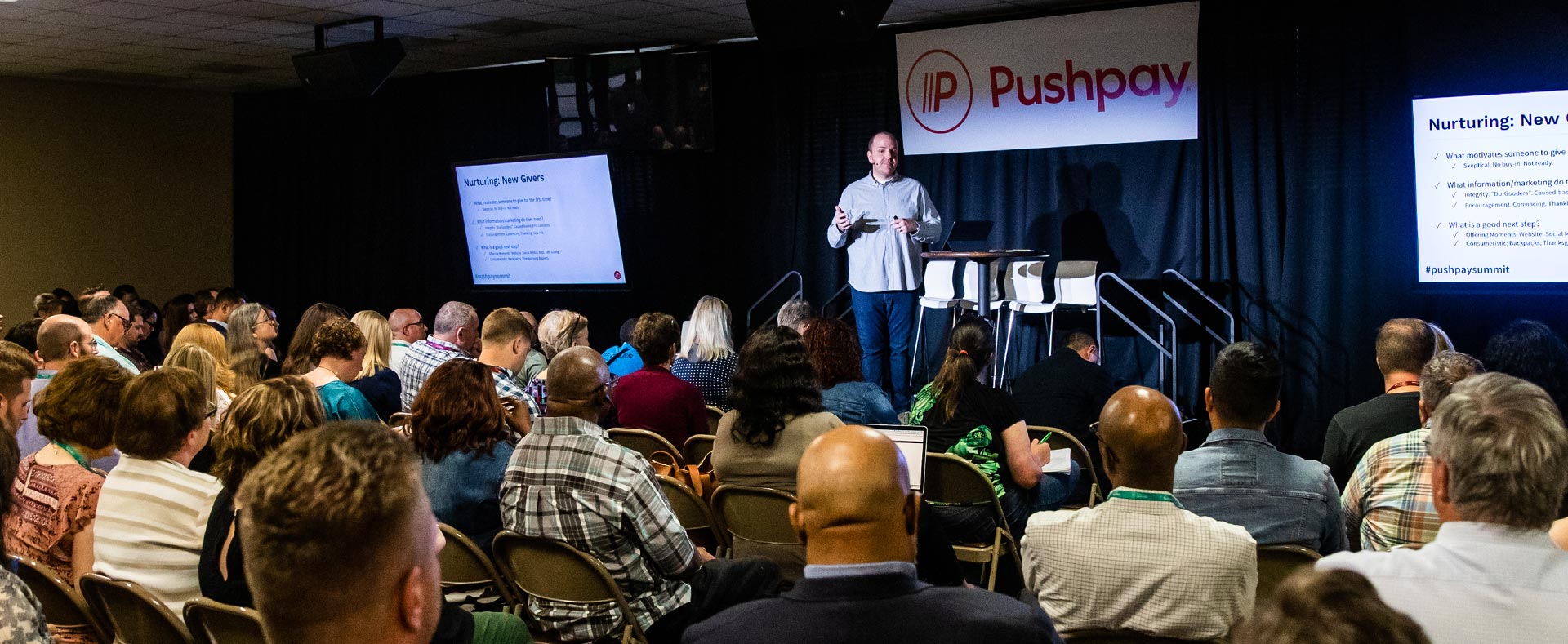
Donor Development Basics Every Church Should Know
Learn the simple, step-by-step process Alex Calder used to grow Kensington Church’s new and recurring giving beyond what anyone thought was possible.
At the core of donor development is determining how best to nurture people’s generosity and better fund your church’s vision. That doesn’t translate into strong-arming people to make big donations from their Christmas bonus. And it certainly doesn’t mean talking about giving once a year hoping that the gifts will flow in abundantly. Donor development is much more strategic, subtle, and donor-focused.
And it looks different at every church.
But Alex Calder, director of donor development at Kensington Church has some incredible insights to help guide every church’s donor development strategy. In fact, he not only implemented a successful development strategy at Kensington Church, but has been teaching other churches how to do it as well.
At the Pushapy Summit 2019 conference, he spent some time talking through the importance of nurturing donors to create a better culture of generosity at Kensington. And he also touched on a number of strategies they use to increase giving organically and with their unique donors in mind. Here are the takeaways from his session.

Establish Your Church’s Foundations
Kensington is a 16,000-person, multisite church in Michigan and has consistently grown giving alongside attendance. The thing is, giving has grown even beyond natural attendance growth at the church and it’s because Alex has spearheaded a donor strategy based on three key things:
Who should focus on donors?
Donor development should be a priority for all staff since their roles all impact or interact with donors at some level. The church as a whole is asking people to invest in its mission and vision, and staff and volunteers are all very visible bearers of that mission. If asked to collaborate on donor development strategies, they should readily step in to assist on tactics to help fund the church’s mission.
But while it’s true that everyone plays a part, the chief fundraiser is the person who gets up on stage on Sundays to lead in the giving moment.
That’s the person people are actually giving to—so it’s really important for them to be trustworthy. They’re not only leading the offering moments but key in communicating the vision and mission of the church.
Nurturing People Toward Deeper Generosity
While donor development tactics vary from ministry to ministry, one of the few things that stays the same among churches with successful donor development practices is good data. Giving platforms like Pushpay help churches understand their donors’ giving habits so they can create strategies that respond well to how people are currently giving. To hear how the Pushpay platform helps churches nurture generosity and fund their vision, click here to talk to one of our experts.
Alex uses Pushpay and Rock RMS to target three key groups: New, major, and electronic donors.
Nurturing New Donors
People who give for the first time are essentially dipping their toes into the pond to feel things out. According to Alex, new donors don’t think, act, nor give like everyone else and it’s important for churches to present them with unique information/marketing materials to nurture their generosity. Understanding these donors and what motivates them is also key to knowing how best to thank them.
Understanding First-Time Donors
These donors are often skeptical in some way—whether of the church’s vision or of church + money in general. They’re also not bought into the mission and it’s often because churches aren’t teaching it well enough. For many of these donors, they don’t have the financial means to give but they will donate if there’s an easy enough entry-point to giving.
What Alex and his team noticed over the years is that new donors tend to be “do-gooders.” They want a feel-good experience when they give and want to know exactly how their donation will impact real people and real circumstances. As opposed to investing in the mission and vision of the church, these donors want to see an almost tangible return on their gift.
Kensington uses fairly traditional avenues to communicate with them: Offering moments, websites, and social media. They also use their giving app and encourage text giving since it’s an easy avenue for first-time donations.
Kensington’s strategy
Alex believes that once a church identifies it’s new donors, first-time gift asks have to be incredibly low risk. And middle-of-the-road strategies won’t rally their generosity.
Alex and his team created an entry-point to giving campaign around back-to-school to mobilize new donors. The feel-good campaign asked people to donate $20 and the church will use the money to buy a backpack for a child in need at a local neighborhood. They chose $20 because it’s a manageable amount for people to donate.
Donors who give to this initiative are showing an interest in generosity. Now the church knows who’s willing to be generous and can follow up by email asking them to give again. Kensington then asks these donors to give to the Thanksgiving campaign, where $40 buys local families a Thanksgiving meal. The second gift is the most important gift because it shows that the person is invested.
Once someone has given their second gift, on average, there’s an 83% chance that they will give again.” —Alex Calder, director of donor development at Kensington Church
Alex and his team continue to communicate with these second-time donors and introduce them to other giving opportunities. With time, many of these new donors transition from feel-good giving to making dedicated financial investments to the overall church vision and mission. But Alex says this takes constant, meaningful communication with these donors, whether by email, during the offering moment, social media etc.
First-Time Donor Follow-Up
Of all donors, new donors especially need a lot of encouragement and immediate thank-yous. The thing is, automated thank you emails are not good enough—you have to send a personalized thank you.
According to Alex, the details do matter. An envelope with a return address sticker looks impersonal and mass-produced. So at Kensington, thank you cards have a lot of white space and they’re sent out to campus pastors who then spend time writing a line or two of thanks and acknowledgment on each card. Volunteers then hand-address the envelopes and cards are promptly dropped in the mail on Tuesdays so new donors get a personalized thank you before church the following Sunday. Kensington also includes small bits of swag in thank you packets. Things like church-branded bumper stickers and refrigerator magnets have been well accepted by their donors.
New donors who hit a certain threshold of giving are also invited to donor dinners. The focus of these meals is to thank donors and talk through opportunities for them to get more involved in the life of the church. This is a simple but meaningful touchpoint to nurture continued engagement between the church and their donors and ensure people have the support they need to grow spiritually within the church.
Nurturing Majors Donors
When it comes to major donors, their motivations are night-and-day different from first-time donors. Keep in mind that who counts as major donors at each church will be different, but it’s important to properly identify members of this group to best nurture their generosity.
Understanding Major Donors
These higher-tier donors openly support the church’s mission—they’ve already opted in, they’ve made multiple gifts, and they’re involved in the life of your ministry. These donors often feel a sense of obedience to God, their church, and pastor. They also have high trust typically and understand exactly what they’re giving to.
Keep in mind: Even if people are fully bought into your mission, if they don’t like the founder or face of the church, they’ll never give. This is something your leaders should take a critical look at—if main leaders are scandalized often, it hinders the natural generosity of all donors, but especially your major donors.
These are also your most joyful donors.
And they’re the people who tend to seek out great preaching and teaching, small groups that openly talk about money, discipleship programs, and mission trips. Major donors need many touchpoints and personal time in order to feel fully invested in your church.
Kensington’s Strategy
Pause. It’s been a mouthful of information so far but let’s slow down here. Targeting major donors has been historically taboo within the church—Alex acknowledges this. However, ministries typically appreciate other large sacrifices like people giving up their Sundays to serve in the Sunday school or long-term volunteers. But churches tend to be nervous about thanking major donors. The thing is, major donors help your church run and it’s very important to honor, appreciate, and nurture them.
Since these donors are so high-touch, Alex is very careful to identify multiple different groups of major donors using their Pushpay and Rock RMS platforms, and communicate to each group slightly differently.
He acknowledges that the Kensington model for major donors won’t work for every church, and encourages ministries to figure out what will work best for their members. While the goal with new donors is to establish low-risk entry points for giving, with major donors, the focus is on establishing meaningful touchpoints along with thanking them well.
Kensington’s major donors get custom cards when they hit a cumulative gift amount for that year. Like new donors, major donors are also blessed with periodic appreciation dinners—but the focus is different. For them, church leaders share high-level vision and big things like new campuses being launched. Church leaders get a chance to share what donors’ giving helped accomplish, new avenues for engagement and participation, and the church’s roadmap for the next quarter. Because there are usually fewer people in this group, the event tends to be intimate and high-touch.
On a more personal note, Alex also calls people to say thank you for especially large gifts and to ask how he can pray for them. For Kensington’s major donors, this isn’t just a thank you, but a pastoral moment to connect with the church and feel a deeper sense of connection with their local ministry.
Same with new donors, major donors also get personalized thank you cards and swag. Every quarter, the team changes the background images on the cards to keep things fresh.
Nurturing Digital Donors
If you guessed that ease-of-use motivates mobile donors—you’re right. According to Alex, making giving easier improves the likelihood that people will commit to a gift. But Alex doesn’t recommend stopping there. He also encourages churches to have a very intentional dialogue around digital giving—recurring giving more specifically.
Churches nationwide are encouraging recurring donations and seeing excellent results from their efforts. In fact, Kensington’s recurring giving is at 83% and, since switching to Pushpay, they’ve curbed summer seasonal dips in giving and stabilized their budget.
Having a 10-second giving experience with Pushpay helps Kensington donors tap into their generosity easily and without hassle. But just having a platform isn’t enough—nurturing digital donors requires intentionality and frequent communication. Talk about how easy it is to take the next step to give via the church app and mention how many other people are doing it. Communicate it loudly and often.
Nurturing Connection With Digital Donors
But don’t just stop at nurturing your digital donors. Some of these donors may not be active attendees at your church—do you have a plan for engaging them beyond their generosity? If your church offers an online ministry, invest in a strategic plan for helping them deepen their connection with your church. While online attendees who also donate are fairly engaged, it’s important to continually connect their giving with your church’s mission and provide multiple opportunities for them to connect.
Maybe your church believes that online ministries are as powerful and engaging and in-person ones. Or maybe you opt to transition online attendees to physical churchgoers. Wherever you are on that spectrum, be sure to establish an online pastor to disciple digital attendees. This person will be responsible for the spiritual health and growth of people who opt to worship via web streaming. Leadership should be accompanied by small groups, volunteer opportunities, chat groups, and other ways to get involved and connect with others.
Some church app features can help nurture deeper engagement and belonging. So if you, like Kensington, use the Pushpay app, be sure to take advantage of features like digital connect cards, impact cards, related content, and dynamic home screen to communicate what the church is doing, why it matters, and how people can get plugged in.
Kensington’s Strategy
Digital giving is a huge part of Kensington’s donor development strategy. And not just to serve timid new donors but to develop a stronger overall culture of generosity.
Kensington nurtures these donors by using giving slides during the offering moment to let people know the many ways they can give. They also use emails and videos reminders. The key is to be consistent and persistent. A simple P.S. in a general monthly church email that says “Have you signed up for recurring giving?” can remind people of their options and how to set up a recurring schedule.
Kensington also sends dedicated mailers each summer that reads “Don’t let your giving go on vacation,” reminding people to set up their gifts. They even sent out cards that share people’s generosity-focused testimonies and walk through the easy steps to set up a recurring gift. That way, people then get to hear from a peer, not from the church. That’s relatable and extremely compelling.
Alex and his team also use social media to heavily promote text-to-give since that makes it easy for friends and followers of the church to quickly donate. Text donors through Pushpay receive a custom thank you note which then prompts them to download the giving app for future gifts. Kensington has had enormous success in moving people to app giving.
Contrary to popular belief, older congregants aren’t scared of mobile giving—most embrace the ease and convenience of digital giving. That’s why it’s really important to encourage that avenue at your church.
Squelching Fear of Giving
Alex cited fear as the main reason people don’t invest in their churches. Whether it’s fear of surrendering control of one’s finances, surrendering the full self to God, or giving out of lack, fear is everywhere. The role of donor development is to hold people’s hand throughout the process of giving and reduce that fear. You’re letting people know that your church is safe to donate to and their finances are helping build God’s Kingdom. You’re showing them how well you’re stewarding their gifts and celebrating souls won to Christ as a collective church family. And that makes donor development extremely important work for the Church.





